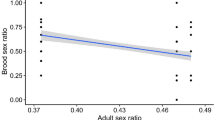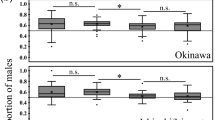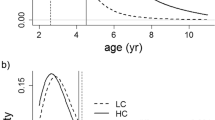Abstract
JUVENILE dispersal is sex-biased in many mammals and birds: one sex often disperses more often or farther than the other. Two hypotheses are generally presented for sex-biased dispersal. The first holds that juvenile dispersal reduces reproductive and/or resource competition between parents and same-sexed offspring1–5. If so, presence of a parent on the natal home range should both promote dispersal of same-sex offspring and suppress reproduction of those that remain. The second is that juvenile dispersal reduces matings between parents and offspring6–10, thus decreasing the likelihood of inbreeding depression11–13. If so, presence of a parent should favour dispersal and reproductive suppression of offspring of the opposite sex. Here I present evidence that juvenile dispersal in white-footed mice, Peromyscus leucopus, is due to inbreeding avoidance. When population density was high, experimental removal of one parent delayed dispersal of opposite-sexed offspring and only the presence of the parents of opposite sex suppressed juvenile reproduction.
This is a preview of subscription content, access via your institution
Access options
Subscribe to this journal
Receive 51 print issues and online access
$199.00 per year
only $3.90 per issue
Buy this article
- Purchase on Springer Link
- Instant access to full article PDF
Prices may be subject to local taxes which are calculated during checkout
Similar content being viewed by others
References
Anderson, P. K. Dispersal in Rodents: A Resident Fitness Hypothesis (Allen, Kansas, 1989).
Dobson, F. S. Anim. Behav. 30, 1183–1192 (1982).
Waser, P. M. Ecology 66, 1170–1175 (1985).
Moore, J. & Ali, R. Anim. Behav. 32, 94–112 (1984).
Liberg, P. & von Schantz, T. Am. Nat. 126, 129–135 (1986).
Wolff, J. O. et al. Anim. Behav. 36, 456–465 (1988).
Clutton-Brock, T. H. Nature 337, 70–72 (1989).
Greenwood, P. J. Anim. Behav. 28, 1140–1162 (1980).
Pusey, A. Trends Ecol. Evol. 2, 295–299 (1987).
Cockburn, A. et al. Anim. Behav. 33, 908–915 (1985).
Ralls, K. et al. in Conservation Biology (ed. Soule, M. E.) 35–56 (Sinauer, Sunderland, Massachusetts, 1986).
Haigh, G. J. Mammal. 64, 48–54 (1983).
Keane, B. Anim. Behav. 39, 264–273 (1990).
Wolff, J. O. Can. J. Zool. 63, 1548–1555 (1985).
Wolff, J. O. Can. J. Zool. 63, 2657–2662 (1985).
Wolff, J. O. Va, J. Sci. 37, 209–220 (1986).
Wolff, J. O. & Cicirello, D. M. Behavl Ecol. 2, 38–45 (1991).
Wolff, J. O. et al. Behavl Ecol. Sociobiol. 12, 237–242 (1983).
Wolff, J. O. in Advances in the Study of Peromyscus (Rodentia) (eds Kirkland, G. L. Jr & Layne, J. N.) 271–291 (Texas Technical University Press, Lubbock, Texas, 1989).
Hestbeck, J. B. Oikos 39, 157–163 (1982).
Packer, C. Anim. Behav. 33, 676–678 (1979).
Harvey, P. H. & Ralls, K. Nature 320, 675–676 (1986).
Marks, J. S. & Redmond, R. L. Am. Nat. 129, 158–164 (1987).
Hoagland, J. L. Science 215, 1639–1641 (1979).
Koenig, W. D. & Pitelka, F. A. Science 206, 1103–1105 (1979).
Holzenbein, S. & Marchinton, R. L. J. Wildl. Magmt 56, 147–153 (1992).
McCravy, K. W. & Rose, R. K. J. Mammal. 73, 151–159 (1992).
Author information
Authors and Affiliations
Rights and permissions
About this article
Cite this article
Wolff, J. Parents suppress reproduction and stimulate dispersal in opposite-sex juvenile white-footed mice. Nature 359, 409–410 (1992). https://doi.org/10.1038/359409a0
Received:
Accepted:
Issue Date:
DOI: https://doi.org/10.1038/359409a0
This article is cited by
-
Short and long-term costs of inbreeding in the lifelong-partnership in a termite
Communications Biology (2022)
-
Female polyandry dilutes inbreeding in a solitary fast-living hibernator
Behavioral Ecology and Sociobiology (2021)
-
Social regulation of female reproduction in the steppe lemming, Lagurus lagurus
Mammal Research (2021)
-
Functional connectivity of the white-footed mouse in Southern Quebec, Canada
Landscape Ecology (2017)
-
The effects of maternal presence on natal dispersal are seasonally flexible in an asocial rodent
Behavioral Ecology and Sociobiology (2015)
Comments
By submitting a comment you agree to abide by our Terms and Community Guidelines. If you find something abusive or that does not comply with our terms or guidelines please flag it as inappropriate.



